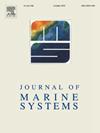Marine environmental variability in Northern Patagonia (Southwestern Atlantic Ocean) as recorded in Glycymeris longior shells
Abstract
Certain marine regions in the world lack long instrumental records of environmental variables or such records are incomplete. This deficiency particularly applies to Argentine Patagonia, where existing instrumental records span only the last few decades. In the present study it was explored whether such data can be reconstructed from a natural archive, specifically shells of the bivalve mollusk Glycymeris longior from the San Matías Gulf, north Patagonia. For this purpose, a multidecade-long time-series was constructed using variations in the annual shell growth. The time-series spans from 1890 to 2020 and is based on shells from museum collections (live-collected from 1918, 1933 and 1945) and from scientific surveys conducted between 1989 and 2021. An analysis of the links between environmental variables and shell growth was performed between 1976 and 2020 (expressed population signal >0.85). The common signal among the growth curves of individual specimens of G. longior suggests that the growth is influenced by environmental parameters. However, the growth of G. longior did not show significant correlations with the low- nor with the high-frequency components of SST and food supply (chlorophyll-a concentration and POC), suggesting that these parameters do not limit shell growth at the studied site or were undetected with our analyses. The chronology also seems to be insensitive to regional climate patterns such as the Southern Annular Mode. The chronology has the potential for being expanded spatially and temporally.

 求助内容:
求助内容: 应助结果提醒方式:
应助结果提醒方式:


